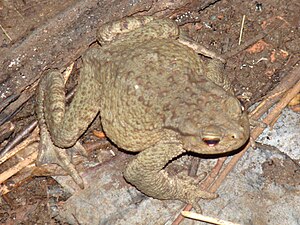Colchian toad
| Colchian toad | ||||||||||||
|---|---|---|---|---|---|---|---|---|---|---|---|---|

Colchian Toad ( Bufo verrucosissimus ) |
||||||||||||
| Systematics | ||||||||||||
|
||||||||||||
| Scientific name | ||||||||||||
| Bufo verrucosissimus | ||||||||||||
| ( Pallas , 1814) |
The colchian toad ( Bufo verrucosissimus ) is a species of amphibian from the toad family (Bufonidae).
features
Adult toads
The colchian toad is a large toad with a head-trunk length of 91.5 to 190 millimeters in females and 70 to 97 millimeters in males. It is very similar to the common toad ( Bufo bufo ). Differences can be found in body size and proportions, the texture of the skin, coloration, tongue shape and greater sexual dimorphism . The males have no vocal sacs . The second and third toes have paired joint bumps (subarticular bumps). There is no tarsal fold . There are oval and large warts on the upper side of the body, while only small warts on the abdomen. The back is gray or light brown in color and has dark spots. Longitudinal ligaments are present on the ear glands, which differ in strength. The belly is gray or yellowish in color. Males are much smaller than the females.
Clutches, tadpoles and young animals
The clutch of the Colchian Toad consists of 1,121 to 10,500 eggs arranged in three rows. The spawn consists of two spawning cords that are 3.5 to 7.5 centimeters long. The tooth formula of the tadpoles is 1: 1 + 1/3. The clearly recognizable lips resemble a suction cup. The upper edge of the tail is light brown. Directly before the metamorphosis, the tadpoles have a total length of 22 to 29 millimeters. The head-trunk length of the young animals after the metamorphosis is 10 to 23 millimeters. They are gray-bronze or orange in color, their ear glands are yellowish.
Occurrence
The distribution area of Bufo verrucosissimus is the Caucasus . In the West Caucasus, the species can be found on both the north and south sides of the Russian-Georgian Caucasus Mountains and penetrates east to Akhaldaba on the Kura . Isolated occurrences are known from the Zaqatala and Talysh regions in Azerbaijan. Finds from the banks of the Chrami and Grozny , Chechnya are uncertain .
The habitat of the species are mountain forests (both coniferous, mixed and deciduous forests), as well as forest edges, bushes and clearings. The toad prefers moist and shady habitats . Holes and hollows under tree trunks and stones are used as hiding places. Specimens of the species were also found in knotholes of crooked trees 1.5 to 2 meters above the ground. The spawning grounds are clear and fast or slow flowing bodies of water such as springs, streams or small rivers. Every now and then, artificial bodies of water such as cisterns and water basins are also accepted. The population density of Bufo verrucosissimus is 70 to 140 animals per hectare.
Way of life
The colchian toad exhibits diurnal activity similar to that of the common toad. Activity maxima in summer are in the period from 8 p.m. to midnight. When the temperatures drop to 4 to 7 ° C at the end of October or December, the winter rest, which lasts until February / March, sets in.
supporting documents
- Sergius L. Kuzmin: The amphibians of Russia and neighboring areas. In: Die Neue Brehm-Bücherei Vol. 627. Westarp Wissenschaften, Magdeburg 1995, ISBN 3-89432-457-0 , pp. 174-179.
Web links
- Bufo verrucosissimus inthe IUCN Red List of Threatened Species 2013.1. Posted by: Boris Tuniyev, Göran Nilson, Natalia Ananjeva, Aram Agasyan, Nikolai Orlov, Sako Tuniyev, Steven Anderson, Sergius Kuzmin, Matthias Stöck, Theodore Papenfuss, Nasrullah Rastegar-Pouyani, Ismail Ugurtas, David Tarkhnishvili, Sergius Kuzmin, Matthias Stöck Theodore Papenfuss, Nasrullah Rastegar-Pouyani, Ismail Ugurtas, Steven Anderson, David Tarkhnishvili, Natalia Ananjeva, Nikolai Orlov, Boris Tuniyev, 2008. Retrieved November 19, 2013.